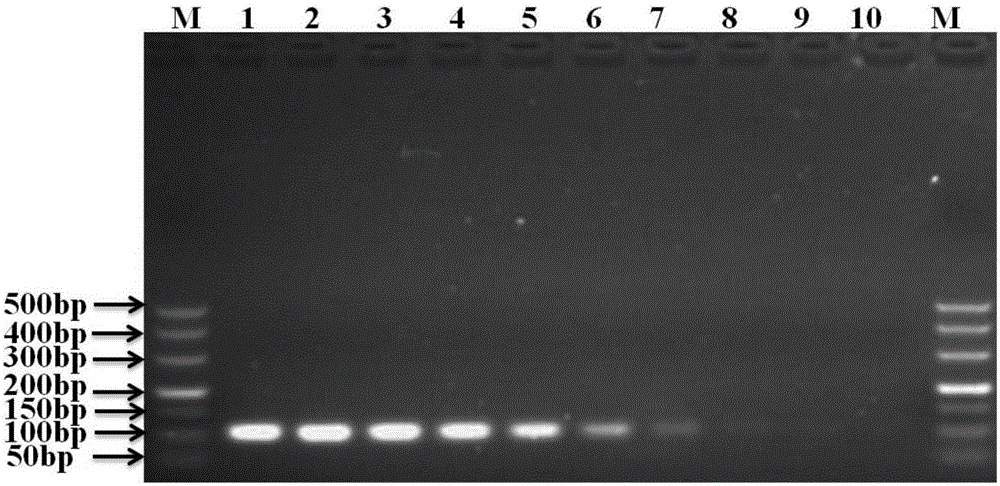Kit for detecting pasteurella multocida in environmental aerosol sample, and application of kit
A Pasteurella, detection environment technology, applied in the field of microbial detection, can solve the problems of high sensitivity requirements of detection methods, difficulty in collecting aerosol samples, low bacteria, etc., and achieves the effect of low cost, accuracy and practicability
- Summary
- Abstract
- Description
- Claims
- Application Information
AI Technical Summary
Problems solved by technology
Method used
Image
Examples
Embodiment 1
[0059] Example 1: Design of primers and probes
[0060] Referring to the Kmt1 gene specific to Pasteurella multocida in GeneBank (GengBank No.AF016259), two pairs of specific primers and probes were designed using Primer Express 3.0 software. The specific sequences are shown in Table 1. When designing the primers, the conservation of the Kmt1 gene in the primer design region was firstly BLASTed on the Genebank data, all of which matched 100% with Pasteurella multocida strains. Then BLAST comparison was performed on the designed upstream and downstream primers and probes, and it was found that none of them matched with other gene sequences, which ensured the specificity of the primer sequences. A pair of optimal primers (shown in SEQ ID NO.1 and SEQ ID NO.2) and probe (shown in SEQ ID NO.3) were screened through pre-experimentation, synthesized by Huada Gene, and expected to amplify DNA product 101bp.
[0061] Table 1 Pasteurella multocida specific primer pairs and probe sequ...
Embodiment 2
[0063] Example 2: Establishment of a method for detecting Pasteurella multocida in environmental aerosol samples and investigation on the sensitivity and specificity of the detection method
[0064] 1. Amplification of a partial fragment of the Kmt1 gene of Pasteurella multocida
[0065] Using Pasteurella multocida positive disease DNA as a template, apply upstream primer Pm-F: 5'-TTGGTGTGTTGAGCCAATCTG-3' (shown in SEQ ID NO.1) and downstream primer Mb-241-R: 5'-ATTAAACCGTTGGAACACGAAGA -3' for amplification. The reaction system is 50 μL: 10×LA PCR Buffer II (Mg 2+Plus) 5 μL, 2.5mM dNTP Mixture 8 μL, LA Taq 0.5 μL (5U / μL), template 2 μL, 10 μmol / L upstream and downstream primers 1 μL, sterilized ultrapure water 32.5 μL. The reaction program was pre-denaturation at 94°C for 3 min, followed by 30 cycles at 94°C for 30 s, 58°C for 30 s, and 72°C for 30 s, and a total of 32 cycles; extension at 72°C for 10 min, and finally stopped at 4°C. The PCR products were identified by agar...
Embodiment 3
[0084] Embodiment 3: The kit that is used for the detection of Pasteurella multocida
[0085] The composition of kit: the primer and probe combination that embodiment 1 designs, positive standard plasmid, negative control and real-time fluorescence quantitative PCR (qPCR) reagent (commercial product, conventional kit in the prior art);
[0086] The positive standard plasmid consists of the pEASY-T3 recombinant plasmid consisting of a nucleotide fragment as shown in SEQ ID No.4 (241 bases); the details are as follows:
[0087] 5'-TTGGTGTGTTGAGCCAATCTGCTTCCTTGACAACGGCGCAACTGATTGGACGTTATTTTATTACTCAGCTTATTGTTATTTGCCGGTTTATATTTCCCTTGTCAGTCTGATTTATCAATATTTCCCATGTTGAGTTACGTTTCTTATGGCCATTATTGAAGCCATTAACGACAGAGCGGTTTAATTTATTTTATCGTGTATTGGTTACTATTTTGGTCTTTTACTCGT'(
[0088] The negative control is pEASY-Y3 empty plasmid standard
PUM
 Login to View More
Login to View More Abstract
Description
Claims
Application Information
 Login to View More
Login to View More - R&D
- Intellectual Property
- Life Sciences
- Materials
- Tech Scout
- Unparalleled Data Quality
- Higher Quality Content
- 60% Fewer Hallucinations
Browse by: Latest US Patents, China's latest patents, Technical Efficacy Thesaurus, Application Domain, Technology Topic, Popular Technical Reports.
© 2025 PatSnap. All rights reserved.Legal|Privacy policy|Modern Slavery Act Transparency Statement|Sitemap|About US| Contact US: help@patsnap.com



